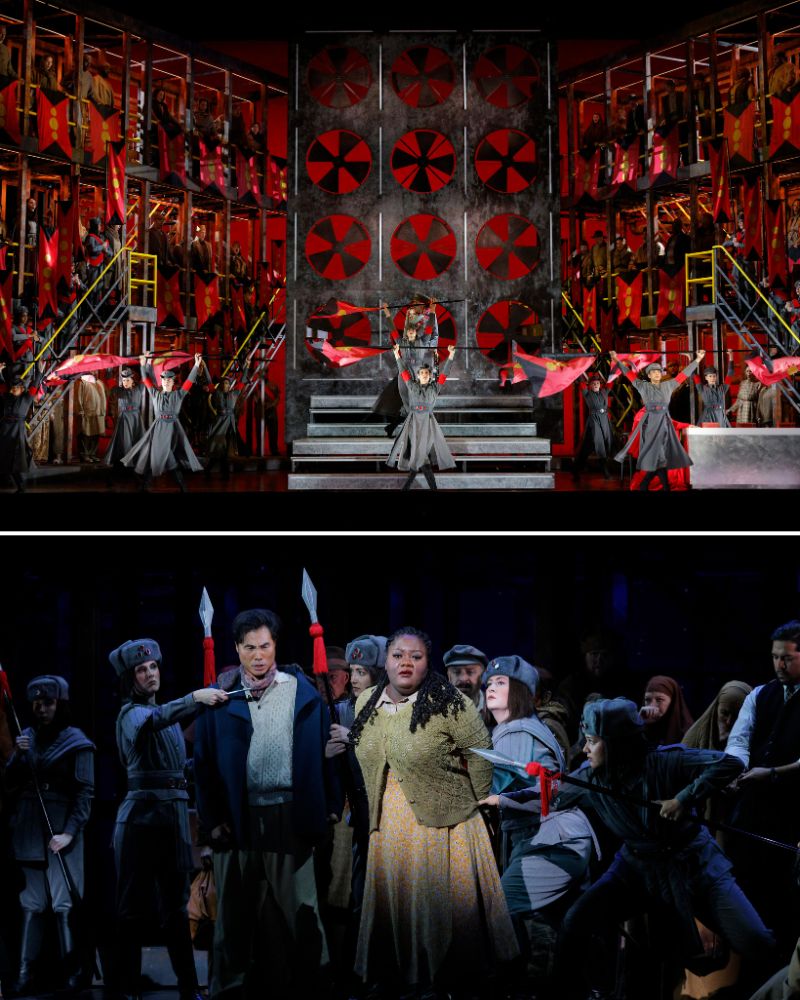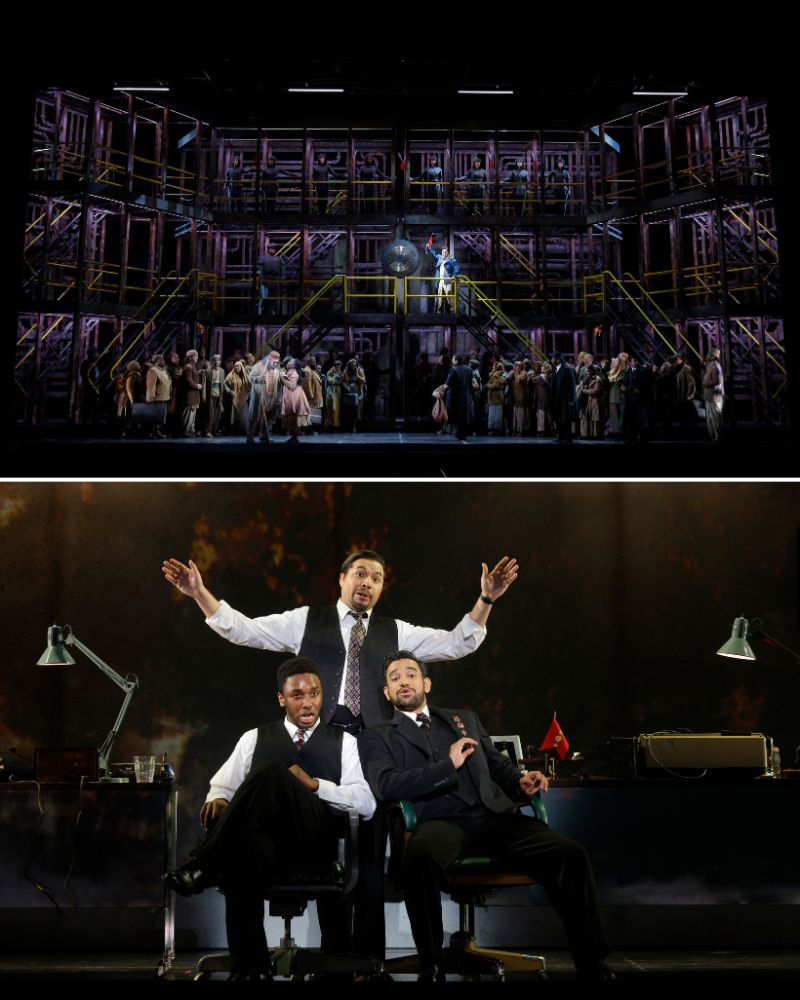Giacomo Puccini’s operatic tale of a cruel Chinese princess, who seeks to put to death her succession of suitors, receives a radical rethinking, including a new “world premiere ending,” by Director Francesca Zambello and the creative team at Washington National Opera. I’ve noted before Zambello’s prescience in her approach to directing grand opera (most notably in her 2016 full Wagner Ring Cycle, setting Wotan’s realm of power in Trump Tower). Here, for Turandot, she’s upended the world order, exchanging Puccini’s highly imagined Imperial China for a modern totalitarian regime — could be China, the Soviet Union, or North Korea — and litters the stage with the resulting crisis of refugees in forced global migration. Zambello’s Turandot resonates for our times like hitting the sweet spot of a gong.
Why tamper with Puccini’s greatness? some might ask. But Puccini died before he could finish the opera, his last and many think his greatest masterpiece. Perhaps the patchwork solution by friend and student Franco Alfano, rifling through Puccini’s notes and sketches, invited further examination and reworking. Zambello, who first directed the opera in 1997, has long thought so.

But it has taken this long to assemble the considerable forces of the opera’s musical and dramatic ambitions. A total of 275 artists — including 59 chorus members, an additional 20 child choristers, 10 dancers, 12 supernumeraries, and possibly the largest orchestra ever assembled by the company — bring to the stage the tale of how a world under the rule of a very bad leader can take us all so perilously close to the precipice.
The production brought in two-time Grammy-award-winning composer Christopher Tin (most interestingly Tin holds a first-time win for a video game theme score) and Emmy-award-winning TV and film writer Susan Soon He Stanton to fashion a modern, “more acceptable” end to the story of the capitulation of a powerful female ruler than a requisite smooch. Stanton’s solutions to Zambello’s problems with the work’s original ending work admirably. Tin’s music is muscular and modern without losing satisfying, even gorgeous melodic lines. I hope these two artists continue operatic collaborations; they succeeded in working the principles of the compressed textual writing and other demands of this hybrid performance form while still serving Puccini’s lush homage to romantic love.
Turandot’s world is symbolized by a guillotine contraption wheeled on and off. Its slicing sound, imbedded in the score, serves to incite the assembled throng to call for more blood and keeps the people cowered in fear.
Linda Cho’s costume designs beautifully render a three-tiered society: chorus members, many wearing earth-colored head coverings and shawls that flap and flutter, represent global refugees at a cultural crossroads, and, when they drop to the ground exhausted, become a pile of rags; dancers and functionaries call up militaristic red guard parades. When Turandot enters, she represents the ruling class, through alternating statements in bold red then black fashion.
Wilson Chin’s stage design, incorporating huge three-story scaffolds, conveys a seething population that must be managed by corralling them in vertical cages. (And how else to get in such a monstrous representation of stadium-sized crowds on stage?) Impressive, although the size and geometric decorations made the stage, at times, overly busy. Fabulous were S. Katy Tucker’s rear projections, often peeking through the scaffold slats, most especially the spherical moon and fiery golden sun disc, and they worked in tandem with Amith Chandrashaker’s lighting designs to transport the audience emotionally through the story from darkness to bright day.
The grand scale of all the design elements was matched throughout the evening by the sheer vocal presence of the chorus in some of opera’s greatest choral writing.

Nonetheless, one of the most revelatory and radical of scenes in the production stood out in part because of a less-is-more simplicity, representing the office of three ministers, a squat gray bureaucratic world, where the only adornment came in the requisite portrait of the political leader displayed on the upstage wall. The three characters in Puccini’s original opera (Ping, Pang, and Pong) are often reduced to clownish, commedia-inspired caricatures. They are referred to in this production as ministers and given real functionary responsibilities. Therefore we see them as real people, albeit shunted into the mindless politburo. Ethan Vincent (Chancellor), Sahel Salam (Majordomo), and Jonathan Pierce Rhodes (Head Chef) interact beautifully and imbue their characters with both touches of humor and great humanity, especially in the heartfelt rendition of what I call “the homesick trio,” one remembering his house on a lake, another the surrounding forest of his estate, and one his beautiful garden, all far away from the brutal regime and industrialized graying of humanity.
Ewa Plonka makes her debut with WNO, singing the titled role, a princess of fire and ice. She is appropriately steely and impressive as she strides across the stage and has a voice that can dominate all the forces that the grand-sized orchestra throws at her. In her first scene, without singing a note, she establishes her character: her eyes harden, her arm slashes through the air signaling execution, as she sends one man after another to his death. (This is due, we learn later, to her vow to never submit to a man in revenge for a long-lost ancestor brutally murdered.) Opening night, truthfully, I detected some tightness in her high notes. But Plonka has mastered well blending Puccini’s melodic writing with the new, especially delivering gloriously the culminating duet by Tin.

Tenor Yonghoon Lee takes us on a romantic hero’s journey with Calaf, convincing me of both his reckless ardor for Turandot and his goodness and compassion for his father and gentle Liù, the serving girl. He excels dramatically in Act II’s central scene, where he builds emotionally how the stakes in answering the three riddles put to testing all suitors become a terrifying fight for his life. Vocally, the demands of the score and the orchestral forces at work make the singer sing full out most of the evening, but he throws himself energetically into every moment. There was one moment when the audience broke out in its heartiest appreciation for the work’s megahit “Questa notte nessun dorma,” and he and the orchestra went ahead, muffling a key transition.
The knock-out discovery of the evening was soprano Masabane Cecilia Rangwanasha, making her debut at WNO in the role of Liù. The integrity of her approach to the character was flawless, and her seemingly effortless vocal technique enabled her sound to flow out like pure liquid silver in every expressive line.
Jessica Lang and Kanji Segawa, co-choreographers, added much to the spectacle by creating energetic dance sequences that drew on the precision style of Chinese parade grounds and the ballet “Raise the Red Lantern.” The dancers executed these interludes terrifically.
Bravo to Speranza Scappucci, who returned to WNO to conduct the production. She held the reins firmly, masterfully guiding all the elements at work. She delivered Puccini’s complicated harmonic structures and brought Puccini’s and Tin’s music together in a satisfying whole.
This was indeed a powerful evening of grand opera.
Running Time: Two hours 40 minutes with one twenty-five minute intermission.
Turandot plays through May 25, 2024, presented by Washington National Opera performing in The Opera House at the John F. Kennedy Center, Washington, DC. For the schedule and to purchase tickets ($45–$299), go online or contact the Box Office at (202) 467-4600.
The program for Turandot is online here.
COVID Safety: Masks are optional in all Kennedy Center spaces for visitors and staff. Read more about the Kennedy Center’s mask policy here.



